Contents
Physical Therapy Massage Business Plan
Healing Touch Massage is owned by Lavinia Watkins, a Licensed Massage Therapist in Oregon since July 1984, and has operated as a profitable home-based business since its inception.
We offer a variety of massage styles including Swedish Massage, Deep Tissue work, Sports Massage, Hot Stone Massage, Reflexology, and others.
This business plan aims to explore the cost effectiveness of expanding by locating the business downtown. This move would enhance accessibility for full-time workers and make it more convenient for clients with medically-ordered massage therapy. Billing insurance companies for medically required massage is profitable. However, due to the therapy’s nature – short sessions focused on specific body areas – it is crucial for clients to be able to visit the therapist during their lunch hour or work day.
Mission
Our mission is to operate a profitable business by providing therapeutic massage in a caring, professional environment. We offer a variety of massage styles. By tailoring the client’s experience based on initial interview information and in-the-moment feedback, we ensure their comfort and satisfaction, and encourage repeat business. We aim to offer effective massage while respecting personal boundaries, so the experience is both relaxing and energizing for the client and the provider. We are mindful of the overall experience, using quality oils and lotions, appropriate scents, and soothing music, nature sounds or silence according to the client’s preferences.
Objectives
- Increase daytime client numbers by 100% by relocating downtown.
- Boost new client numbers by 50% through local advertising.
- Sublet space in the new location to another Licensed Massage Therapist or personal service provider.
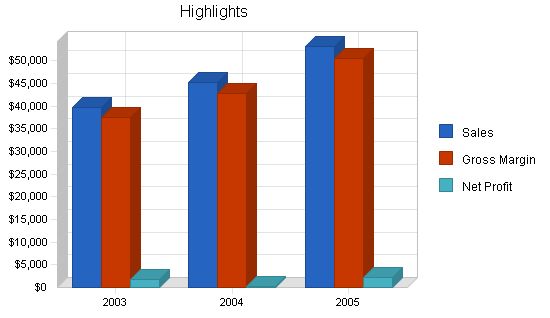
Keys to Success
- Professionalism: Maintain confidentiality, keep LMT training up-to-date, and establish good boundaries between clients and therapist.
- Individual Attention: Customize each client’s experience to their preference.
- Repeat business/Recommendations: Offer service that brings people back for regular treatments and encourages referrals from clients and health professionals.
Company Summary
Healing Touch Massage is a Sole Proprietorship owned by Lavinia Watkins, LMT. Ms. Watkins has been a Licensed Massage Therapist in the State of Oregon since July, 1984, and has operated the business from a home-based location since then. She consistently exceeds the required Continuing Education classes and is proficient in various massage styles, including Shiatsu, Deep Tissue, Sports Massage, Reiki, Watsu, Acupressure, Reflexology, and Integrated Breathing. Ms. Watkins can tailor each massage to meet the client’s needs and preferences.
Company History
Lavinia Watkins, LMT, owner of Healing Touch Massage, has been licensed by the State of Oregon since July 1984. Initial advertising in the local paper helped Ms. Watkins establish a loyal clientele. Many of her clients continue to seek her services, both in-home and at her office. Volunteering at local sports events in the late 80s established her reputation as a Sports Masseuse and attracted long-term repeat clients. In 1993, Ms. Watkins began building referrals from chiropractors, orthopedic surgeons, and other medical professionals. The rise in popularity of Section 125 and other “cafeteria plans” has allowed clients to afford regular massage using pre-tax dollars. In 2000, Ms. Watkins became affiliated with the American Health Specialties Network, expanding her clientele with health insurance coverage for Alternative Care. Ms. Watkins is now considering relocating to a downtown location to increase availability for short-term clients referred by medical professionals.
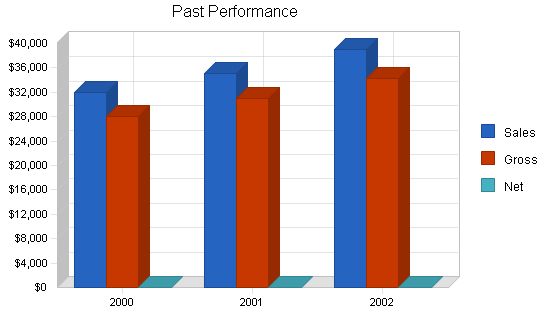
| Past Performance | |||
| 2000 | 2001 | 2002 | |
| Sales | $32,000 | $35,000 | $39,000 |
| Gross Margin | $28,000 | $31,058 | $34,320 |
| Gross Margin % | 87.50% | 88.74% | 88.00% |
| Operating Expenses | $6,500 | $6,800 | $7,000 |
| Collection Period (days) | 0 | 0 | 0 |
| Balance Sheet | |||
| 2000 | 2001 | 2002 | |
| Current Assets | |||
| Cash | $500 | $350 | $1,000 |
| Accounts Receivable | $200 | $350 | $500 |
| Other Current Assets | $50 | $50 | $50 |
| Total Current Assets | $750 | $750 | $1,550 |
| Long-term Assets | |||
| Long-term Assets | $1,200 | $1,500 | $2,000 |
| Accumulated Depreciation | $1,100 | $1,150 | $1,200 |
| Total Long-term Assets | $100 | $350 | $800 |
| Total Assets | $850 | $1,100 | $2,350 |
| Current Liabilities | |||
| Accounts Payable | $50 | $50 | $50 |
| Current Borrowing | $0 | $0 | $0 |
| Other Current Liabilities (interest free) | $0 | $0 | $0 |
| Total Current Liabilities | $50 | $50 | $50 |
| Long-term Liabilities | $0 | $0 | $0 |
| Total Liabilities | $50 | $50 | $50 |
| Paid-in Capital | $800 | $1,000 | $1,200 |
| Retained Earnings | $0 | $50 | $1,100 |
| Earnings | $0 | $0 | $0 |
| Total Capital | $800 | $1,050 | $2,300 |
| Total Capital and Liabilities | $850 | $1,100 | $2,350 |
| Other Inputs | |||
| Payment Days | 0 | 0 | 0 |
| Sales on Credit | $0 | $0 | $0 |
| Receivables Turnover | 0.00 | 0.00 | 0.00 |
Company Ownership
Healing Touch Massage is owned by Lavinia Watkins, LMT.
Services
Healing Touch Massage offers therapeutic massage services.
Market Analysis Summary
The planned move to a downtown location will facilitate access by clients recovering from injuries. This is a lucrative target market because they are usually funded by insurance claims and represent repeat visits for up to one year. This group often requires multiple, short sessions over weeks or months, making a downtown location convenient for mid-day appointments.
Other clients who work during the day would also be more likely to book day-time massages when we are conveniently located near their workplace. Since the number of day-time slots exceeds the number of evening slots, this would generate more business in addition to our current clients.
Market Segmentation
Clients who come for massages fall into four basic groups:
- Clients recovering from injuries or accidents, who often also see a chiropractor or physical therapist (usually referred by a chiropractor). They are frequently paid by insurance, but insurance typically covers short-term therapy only, although clients may sometimes supplement out-of-pocket.
- Individuals with high disposable incomes who may have chronic pain or old injury issues. They receive massages for relaxation 1-4 times a month.
- Clients who use massage as preventative health care and also utilize other alternative practices such as acupuncture, chiropractic, naturopathy, herbalism, etc. They try to have massages regularly, usually once per month.
- Individuals recovering from injuries or working out, who are often serious runners or bicyclists in the local area. They use massage for improved performance and can result in word-of-mouth referrals if they see results.
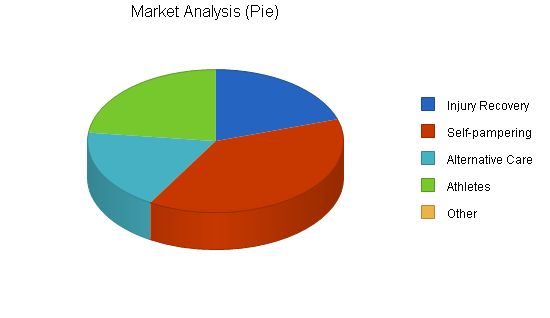
Potential Customers 2003 2004 2005 2006 2007 CAGR
Injury Recovery 3% 156 161 166 171 176 3.06%
Self-Pampering 5% 300 315 331 348 365 5.03%
Alternative Care 5% 144 151 159 167 175 5.00%
Athletes 2% 180 184 188 192 196 2.15%
Other 0% 0 0 0 0 0 0.00%
Total 3.99% 780 811 844 878 912 3.99%
Target Market Segment Strategy:
As clients are unique, they fall into five categories: Injury Recovery, Self-Pampering/Relaxation, Alternative Care Users, Athletes, and Other. These groups require separate marketing approaches.
The Injury Recovery group is mainly referred through chiropractors, self-referrals, or other clients. Marketing is done through referring parties. Health insurance policies may cover massage for injury recovery. The key is to keep getting new referrals.
Clients who indulge in self-pampering or relaxation are our long-term repeat customers. Encouraging a professional relationship while maintaining a personal connection is challenging. Advertising in local alternative news weeklies or donating to charity auctions can attract one-time or long-term clients. Gift certificates are another source of visitors.
Alternative Care users prefer alternative healthcare providers. Networking with these providers and placing advertisements in alternative newspapers can generate referrals. These clients may have limited disposable incomes and book appointments less frequently.
Amateur athletes are loyal and give word-of-mouth recommendations. They may transition from the Injury group and become long-term clients. Chronic injuries and pain increase their likelihood of becoming repeat clients.
Service Business Analysis:
The massage industry consists of individual therapists and LMTs working in various venues. Different clients are attracted to different techniques and personalities. Our unique services cannot be duplicated by any other practitioner.
Competition and Buying Patterns:
Clients trust the professional reputation and skill of the provider. Recommendations from other clients and alternative health service providers are critical. Prices charged for massage services can influence long-term clientele. Clients rarely compare massage therapists directly.
Strategy and Implementation Summary:
Our planned move to a downtown location will increase accessibility to working clients and referring healthcare professionals. The personalized care we offer will result in return clients. We aim to increase business by transitioning insurance-paid injury recovery cases into self-paying clients.
Competitive Edge:
Our competitive edge lies in our ability to provide intuitive massages tailored to each client’s needs. Clients have referred to our services as having "magic hands" and "a higher sense of healing." Our sense of business enables us to maintain a fine balance between personal service and professional boundaries.
Maintaining referrals and creating contacts with health care providers, especially chiropractors, is critical. Becoming a Preferred Provider with health insurance companies that offer Alternative Care is important. Convincing allopathic physicians of the long-term healing benefits of massage can result in insurance coverage.
Sales Strategy:
The best possible massage service is our sales strategy. Each client has specific personal needs, and our goal is to satisfy them through pain relief, relaxation, and increased well-being. Customized services are inevitable due to each client presenting a unique body.
Sales are expected to remain stable. Moving to a more convenient downtown location should increase injury/insurance billing by 50% and self-pampering group by at least 5%. There may be slight seasonality due to increased athlete massage during Spring and Summer months, and gift certificates purchased during holidays and Mother’s Day.
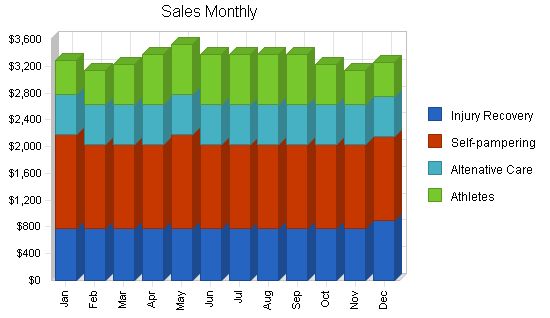
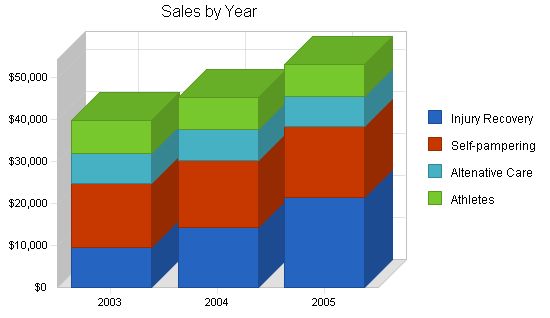
Sales Forecast:
| 2003 | 2004 | 2005 | |
| Sales | |||
| Injury Recovery | $9,480 | $14,220 | $21,330 |
| Self-pampering | $15,300 | $16,065 | $16,868 |
| Alternative Care | $7,200 | $7,200 | $7,200 |
| Athletes | $7,700 | $7,700 | $7,700 |
| Total Sales | $39,680 | $45,185 | $53,098 |
| Direct Cost of Sales | 2003 | 2004 | 2005 |
| Linens | $1,500 | $1,650 | $1,815 |
| Oils & Lotions | $200 | $220 | $242 |
| Insurance Billing | $480 | $528 | $581 |
| Subtotal Direct Cost of Sales | $2,180 | $2,398 | $2,638 |
Management Summary:
Healing Touch Massage is owned by Lavinia Watkins, LMT. Ms. Watkins has been a Licensed Massage Therapist in Oregon since July 1984. She has taken more Continuing Education classes than required and has studied a variety of massage and therapeutic techniques including: Shiatsu, Deep Tissue, Sports Massage, Reiki, Watsu, Acupressure, Reflexology, and Integrated Breathing.
Ms. Watkins holds certificates of completion from the Boulder School of Sports Massage, a Second Level Reiki Degree, and 30 hours of Watsu training. She also practices Ki Akido and is a member of the Eugene Zendo. She has a BA degree from the University of California, Riverside in Urban Studies, with a minor in Business. She is a member of the Oregon Association of Alternative Practitioners and the American Massage Therapy Association.
Personnel Plan:
| 2003 | 2004 | 2005 | |
| Owner Draw | $30,000 | $30,000 | $33,500 |
| Other | $0 | $0 | $0 |
| Total People | 0 | 0 | 0 |
| Total Payroll | $30,000 | $30,000 | $33,500 |
The following Financial Plan represents actual business revenues and expenses for 2003, and a planned increase as a result of a location change.
Another scenario for maintaining income to match the increased expenses of the new downtown location would be to sublet part of the space to another LMT or complementary health care provider. A third scenario would be to try out a downtown location by subletting office space from a chiropractor or in an existing LMT office. Since these last two scenarios are mutually exclusive to the first plan, they are not reflected in financial plans presented here.
Important Assumptions:
The financial plan depends on important assumptions, most of which are shown in the following table as annual assumptions.
The collection days are for insurance billings only, and not easily influenced. Interest rates, tax rates, and personnel burden are based on conservative assumptions.
Two important underlying assumptions are:
- We assume a strong economy, without major recession.
- We assume no changes to the Medical/Insurance Industry, such as the nationalization of health care.
General Assumptions:
| 2003 | 2004 | 2005 | |
| Plan Month | 1 | 2 | 3 |
| Current Interest Rate | 5.00% | 5.00% | 5.00% |
| Long-term Interest Rate | 5.65% | 5.65% | 5.65% |
| Tax Rate | 28.17% | 28.00% | 28.17% |
| Other | 0 | 0 | 0 |
Break-even Analysis:
The following chart and table summarize our break-even analysis. Because this business has been run from a home office, the fixed costs for rent and utilities have been moderate. Moving the business into a downtown location will raise fixed costs substantially.
The break-even assumes minimal variable costs: linens and massage oil. If having a downtown office increases the number of clients paid for by insurance, there will be additional costs for claims processing per client.
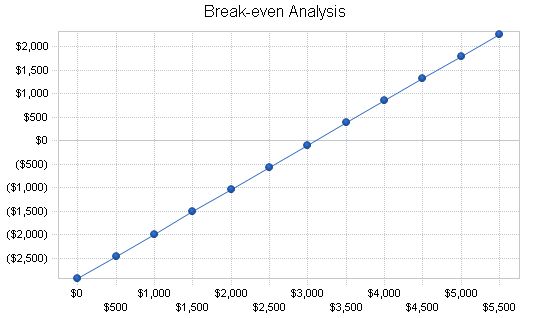
Break-even Analysis
| Monthly Revenue Break-even | $3,101 |
| Assumptions: | |
| Average Percent Variable Cost | 5% |
| Estimated Monthly Fixed Cost | $2,931 |
Projected Profit and Loss
Sales and expenses for 2003 are projected from YTD actuals, and seasonal variations noted over the last few years. The big change comes in 2004 and 2005, with the addition of a downtown office, which will increase the rent dramatically. As noted in the Sales Forecast, the expectation is that the number of Insurance Billing clients will rise as the business becomes more convenient for short, mid-day appointments.
There is no personnel cost other than the owner’s draw, as the company is a sole proprietorship. Payroll taxes are calculated at 15%, however, as Self Employment Taxes (FICA) must also be paid. Estimated taxes will be paid quarterly, although they are calculated monthly on this table.
Not included on this table is the scenario where the Insurance Billing clients do not increase sufficiently quickly to cover the increased cost of rent. At some point, the decision could be made to rent out part of the office space, or rent the entire space to another massage therapist for set times during the week, which would offset the same costs. If a lease needs to be signed, which is most likely for the 2004 year, it will be for one year only, to minimize the risk if the anticipated increase in Insurance Billing clients does not occur.
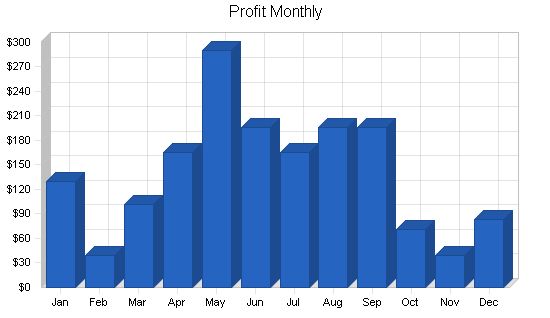
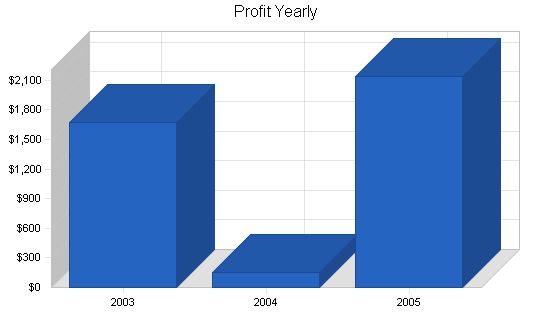
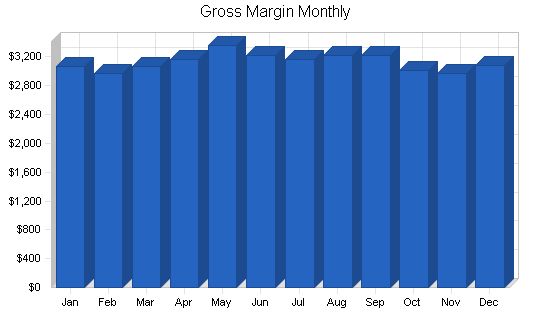
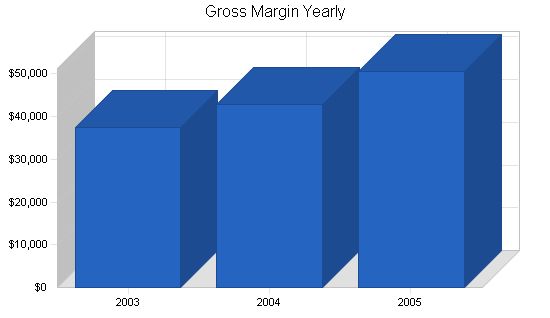
Pro Forma Profit and Loss
Sales: $39,680, $45,185, $53,098
Direct Cost of Sales: $2,180, $2,398, $2,638
Other Costs of Sales: $0, $0, $0
Total Cost of Sales: $2,180, $2,398, $2,638
Gross Margin: $37,500, $42,787, $50,460
Gross Margin %: 94.51%, 94.69%, 95.03%
Expenses
Payroll: $30,000, $30,000, $33,500
Sales and Marketing and Other Expenses: $550, $600, $600
Depreciation: $50, $50, $50
Rent (inc Utilities): $2,400, $9,600, $9,900
Insurance: $636, $800, $1,000
Payroll Taxes: $335, $30, $429
Other: $1,200, $1,500, $2,000
Total Operating Expenses: $35,171, $42,580, $47,479
Profit Before Interest and Taxes: $2,329, $207, $2,981
EBITDA: $2,379, $257, $3,031
Interest Expense: $0, $0, $0
Taxes Incurred: $656, $58, $840
Net Profit: $1,673, $149, $2,141
Net Profit/Sales: 4.22%, 0.33%, 4.03%
Projected Cash Flow
The Cash Flow table below shows consistent positive Cash Flow during the transition. Since the business is a sole proprietorship, the listed amounts as "payroll" are owner’s draw, which implies adjustments can be made in this area if Cash Flow becomes tight.
In 2004, there is a significant increase in Cash outflow for the purchase of Fixed Assets. These expenses would be for fixtures and lease improvement in our new downtown location. Since our current equipment is portable, the cost is relatively moderate, mainly for cosmetic enhancements. There is a possibility that the landlord would handle many of the improvements before we move in, possibly in exchange for a higher monthly rent, which would lessen the impact on cash outflow.
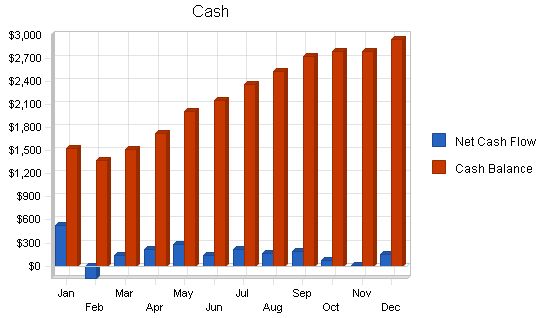
Pro Forma Cash Flow
| 2003 | 2004 | 2005 | |
| Cash Received | |||
| Cash from Operations | |||
| Cash Sales | $34,522 | $39,311 | $46,195 |
| Cash from Receivables | $4,843 | $5,761 | $6,740 |
| Subtotal Cash from Operations | $39,364 | $45,072 | $52,936 |
| Additional Cash Received | |||
| Sales Tax, VAT, HST/GST Received | $0 | $0 | $0 |
| New Current Borrowing | $0 | $0 | $0 |
| New Other Liabilities (interest-free) | $0 | $0 | $0 |
| New Long-term Liabilities | $0 | $0 | $0 |
| Sales of Other Current Assets | $0 | $0 | $0 |
| Sales of Long-term Assets | $0 | $0 | $0 |
| New Investment Received | $0 | $0 | $0 |
| Subtotal Cash Received | $39,364 | $45,072 | $52,936 |
| Expenditures | 2003 | 2004 | 2005 |
| Expenditures from Operations | |||
| Cash Spending | $30,000 | $30,000 | $33,500 |
| Bill Payments | $7,411 | $14,350 | $17,208 |
| Subtotal Spent on Operations | $37,411 | $44,350 | $50,708 |
| Additional Cash Spent | |||
| Sales Tax, VAT, HST/GST Paid Out | $0 | $0 | $0 |
| Principal Repayment of Current Borrowing | $0 | $0 | $0 |
| Other Liabilities Principal Repayment | $0 | $0 | $0 |
| Long-term Liabilities Principal Repayment | $0 | $0 | $0 |
| Purchase Other Current Assets | $0 | $0 | $0 |
| Purchase Long-term Assets | $0 | $2,000 | $2,000 |
| Dividends | $0 | $0 | $0 |
| Subtotal Cash Spent | $37,411 | $46,350 | $52,708 |
| Net Cash Flow | $1,953 | ($1,279) | $228 |
| Cash Balance | $2,953 | $1,675 | $1,903 |
Projected Balance Sheet
The only Accounts Receivable carried is any Insurance Billings that are not paid during the month. It is rare for insurance companies to take more than 6 weeks to pay, and some pay as quickly as 10 working days, so these numbers assume that they will pay in 30 days.
The Accounts Payable is for linens (paid monthly) and lotions/supplies (usually purchased quarterly).
We assume that there will be some additional expenses, in the form of long-term assets purchased, when we move to the new office in 2004.
| 2003 | 2004 | 2005 | |
| Assets | |||
| Current Assets | |||
| Cash | $2,953 | $1,675 | $1,903 |
| Accounts Receivable | $816 | $929 | $1,092 |
| Other Current Assets | $50 | $50 | $50 |
| Total Current Assets | $3,819 | $2,654 | $3,044 |
| Long-term Assets | |||
| Long-term Assets | $2,000 | $4,000 | $6,000 |
| Accumulated Depreciation | $1,250 | $1,300 | $1,350 |
| Total Long-term Assets | $750 | $2,700 | $4,650 |
| Total Assets | $4,569 | $5,354 | $7,694 |
| Liabilities and Capital | 2003 | 2004 | 2005 |
| Current Liabilities | |||
| Accounts Payable | $596 | $1,232 | $1,431 |
| Current Borrowing | $0 | $0 | $0 |
| Other Current Liabilities | $0 | $0 | $0 |
| Subtotal Current Liabilities | $596 | $1,232 | $1,431 |
| Long-term Liabilities | $0 | $0 | $0 |
| Total Liabilities | $596 | $1,232 | $1,431 |
| Paid-in Capital | $1,200 | $1,200 | $1,200 |
| Retained Earnings | $1,100 | $2,773 | $2,922 |
| Earnings | $1,673 | $149 | $2,141 |
| Total Capital | $3,973 | $4,122 | $6,264 |
| Total Liabilities and Capital | $4,569 | $5,354 | $7,694 |
| Net Worth | $3,973 | $4,122 | $6,264 |
Business Ratios
The following table shows the projected business ratios. We expect to maintain healthy ratios for profitability, risk, and return. The ratios for the initial year of growth are not as favorable as the second year. If we cannot maintain healthy ratios during that growth phase, a return to the lesser level of expenses we have historically had in a home-based business can be returned to. Industry profile ratios based on the Standard Industrial Classification (SIC) code 8049.02, Physical therapists, are shown for comparison.
| 2003 | 2004 | 2005 | Industry Profile | |
| Sales Growth | 1.74% | 13.87% | 17.51% | 5.93% |
| Percent of Total Assets | ||||
| Accounts Receivable | 17.85% | 17.35% | 14.19% | 26.64% |
| Other Current Assets | 1.09% | 0.93% | 0.65% | 42.05% |
| Total Current Assets | 83.59% | 49.57% | 39.57% | 73.17% |
| Long-term Assets | 16.41% | 50.43% | 60.43% | 26.83% |
| Total Assets | 100.00% | 100.00% | 100.00% | 100.00% |
| Current Liabilities | ||||
| Accounts Payable | 13.05% | 23.01% | 18.59% | 29.42% |
| Long-term Liabilities | 0.00% | 0.00% | 0.00% | 19.99% |
| Total Liabilities | 13.05% | 23.01% | 18.59% | 49.41% |
| Net Worth | 86.95% | 76.99% | 81.41% |
General Assumptions: |
| General Assumptions | |||||||||||||
| Jan | Feb | Mar | Apr | May | Jun | Jul | Aug | Sep | Oct | Nov | Dec | ||
| Plan Month | 1 | 2 | 3 | 4 | 5 | 6 | 7 | 8 | 9 | 10 | 11 | 12 | |
| Current Interest Rate | 5.00% | 5.00% | 5.00% | 5.00% | 5.00% | 5.00% | 5.00% | 5.00% | 5.00% | 5.00% | 5.00% | 5.00% | |
| Long-term Interest Rate | 5.65% | 5.65% | 5.65% | 5.65% | 5.65% | 5.65% | 5.65% | 5.65% | 5.65% | 5.65% | 5.65% | 5.65% | |
| Tax Rate | 30.00% | 28.00% | 28.00% | 28.00% | 28.00% | 28.00% | 28.00% | 28.00% | 28.00% | 28.00% | 28.00% | 28.00% | |
| Other | 0 | 0 | 0 | 0 | 0 | 0 | 0 | 0 | 0 | 0 | 0 | 0 | |
Pro Forma Profit and Loss:
| Pro Forma Profit and Loss | |||||||||||||
| Jan | Feb | Mar | Apr | May | Jun | Jul | Aug | Sep | Oct | Nov | Dec | ||
| Sales | $3,280 | $3,130 | $3,230 | $3,380 | $3,530 | $3,380 | $3,380 | $3,380 | $3,380 | $3,230 | $3,130 | $3,250 | |
| Direct Cost of Sales | $215 | $165 | $165 | $215 | $165 | $165 | $215 | $165 | $165 | $215 | $165 | $165 | |
| Other Costs of Sales | $0 | $0 | $0 | $0 | $0 | $0 | $0 | $0 | $0 | $0 | $0 | $0 | |
| Total Cost of Sales | $215 | $165 | $165 | $215 | $165 | $165 | $215 | $165 | $165 | $215 | $165 | $165 | |
| Gross Margin | $3,065 | $2,965 | $3,065 | $3,165 | $3,365 | $3,215 | $3,165 | $3,215 | $3,215 | $3,015 | $2,965 | $3,085 | |
| Gross Margin % | 93.45% | 94.73% | 94.89% | 93.64% | 95.33% | 95.12% | 93.64% | 95.12% | 95.12% | 93.34% | 94.73% | 94.92% | |
Pro Forma Cash Flow:
| Pro Forma Cash Flow | |||||||||||||
| Jan | Feb | Mar | Apr | May | Jun | Jul | Aug | Sep | Oct | Nov | Dec | ||
| Cash Received | |||||||||||||
| Cash from Operations | |||||||||||||
| Cash Sales | $2,854 | $2,723 | $2,810 | $2,941 | $3,071 | $2,941 | $2,941 | $2,941 | $2,941 | $2,810 | $2,723 | $2,828 | |
| Cash from Receivables | $250 | $264 | $426 | $407 | $421 | $440 | $458 | $439 | $439 | $439 | $439 | $419 | |
| Subtotal Cash from Operations | $3,104 | $2,987 | $3,236 | $3,348 | $3,492 | $3,381 | $3,399 | $3,380 | $3,380 | $3,250 | $3,162 | $3,247 | |
| Additional Cash Received | |||||||||||||
Pro Forma Balance Sheet
| Pro Forma Balance Sheet | |||||||||||||
| Jan | Feb | Mar | Apr | May | Jun | Jul | Aug | Sep | Oct | Nov | Dec | ||
| Assets | Starting Balances | ||||||||||||
| Current Assets | |||||||||||||
| Cash | $1,000 | $1,532 | $1,371 | $1,515 | $1,732 | $2,007 | $2,151 | $2,365 | $2,531 | $2,727 | $2,794 | $2,798 | $2,953 |
| Accounts Receivable | $500 | $676 | $819 | $813 | $845 | $884 | $883 | $864 | $864 | $864 | $845 | $813 | $816 |
| Other Current Assets | $50 | $50 | $50 | $50 | $50 | $50 | $50 | $50 | $50 | $50 | $50 | $50 | $50 |
| Total Current Assets | $1,550 | $2,258 | $2,240 | $2,378 | $2,627 | $2,941 | $3,084 | $3,279 | $3,445 | $3,641 | $3,688 | $3,661 | $3,819 |
| Long-term Assets | |||||||||||||
| Long-term Assets | $2,000 | $2,000 | $2,000 | $2,000 | $2,000 | $2,000 | $2,000 | $2,000 | $2,000 | $2,000 | $2,000 | $2,000 | $2,000 |
| Accumulated Depreciation | $1,200 | $1,200 | $1,200 | $1,200 | $1,200 | $1,200 | $1,200 | $1,200 | $1,200 | $1,200 | $1,200 | $1,200 | $1,250 |
| Total Long-term Assets | $800 | $800 | $800 | $800 | $800 | $800 | $800 | $800 | $800 | $800 | $800 | $800 | $750 |
| Total Assets | $2,350 | $3,058 | $3,040 | $3,178 | $3,427 | $3,741 | $3,884 | $4,079 | $4,245 | $4,441 | $4,488 | $4,461 | $4,569 |
| Liabilities and Capital | Jan | Feb | Mar | Apr | May | Jun | Jul | Aug | Sep | Oct | Nov | Dec | |
| Current Liabilities | |||||||||||||
| Accounts Payable | $50 | $629 | $571 | $607 | $691 | $715 | $661 | $691 | $661 | $661 | $638 | $571 | $596 |
| Current Borrowing | $0 | $0 | $0 | $0 | $0 | $0 | $0 | $0 | $0 | $0 | $0 | $0 | $0 |
| Other Current Liabilities | $0 | $0 | $0 | $0 | $0 | $0 | $0 | $0 | $0 | $0 | $0 | $0 | $0 |
| Subtotal Current Liabilities | $50 | $629 | $571 | $607 | $691 | $715 | $661 | $691 | $661 | $661 | $638 | $571 | $596 |
| Long-term Liabilities | $0 | $0 | $0 | $0 | $0 | $0 | $0 | $0 | $0 | $0 | $0 | $0 | $0 |
| Total Liabilities | $50 | $629 | $571 | $607 | $691 | $715 | $661 | $691 | $661 | $661 | $638 | $571 | $596 |
| Paid-in Capital | $1,200 | $1,200 | $1,200 | $1,200 | $1,200 | $1,200 | $1,200 | $1,200 | $1,200 | $1,200 | $1,200 | $1,200 | $1,200 |
| Retained Earnings | $1,100 | $1,100 | $1,100 | $1,100 | $1,100 | $1,100 | $1,100 | $1,100 | $1,100 | $1,100 | $1,100 | $1,100 | $1,100 |
| Earnings | $0 | $130 | $169 | $271 | $436 | $726 | $923 | $1,088 | $1,284 | $1,480 | $1,551 | $1,590 | $1,673 |
| Total Capital | $2,300 | $2,430 | $2,469 | $2,571 | $2,736 | $3,026 | $3,223 | $3,388 | $3,584 | $3,780 | $3,851 | $3,890 | $3,973 |
| Total Liabilities and Capital | $2,350 | $3,058 | $3,040 | $3,178 | $3,427 | $3,741 | $3,884 | $4,079 | $4,245 | $4,441 | $4,488 | $4,461 | $4,569 |
| Net Worth | $2,300 | $2,430 | $2,469 | $2,571 | $2,736 | $3,026 | $3,223 | $3,388 | $3,584 | $3,780 | $3,851 | $3,890 | $3,973 |

Business Plan Outline
- Executive Summary
- Company Summary
- Services
- Market Analysis Summary
- Strategy and Implementation Summary
- Management Summary
- Financial Plan
- Appendix
Hello!
I’m Andrew Brooks, a seasoned finance consultant from the USA and the mind behind phonenumber247.com.
My career is built on a foundation of helping individuals and businesses thrive financially in an ever-changing economic landscape. At phonenumber247.com, my aim is to demystify the complex world of finance, providing clear, actionable advice that can help you navigate your financial journey with confidence. Whether it’s personal finance management, investment strategies, or understanding the nuances of market dynamics, I’m here to share insights and tools that can propel you towards your financial goals.
Welcome to my digital space, where every piece of advice is a step closer to financial clarity and success!
